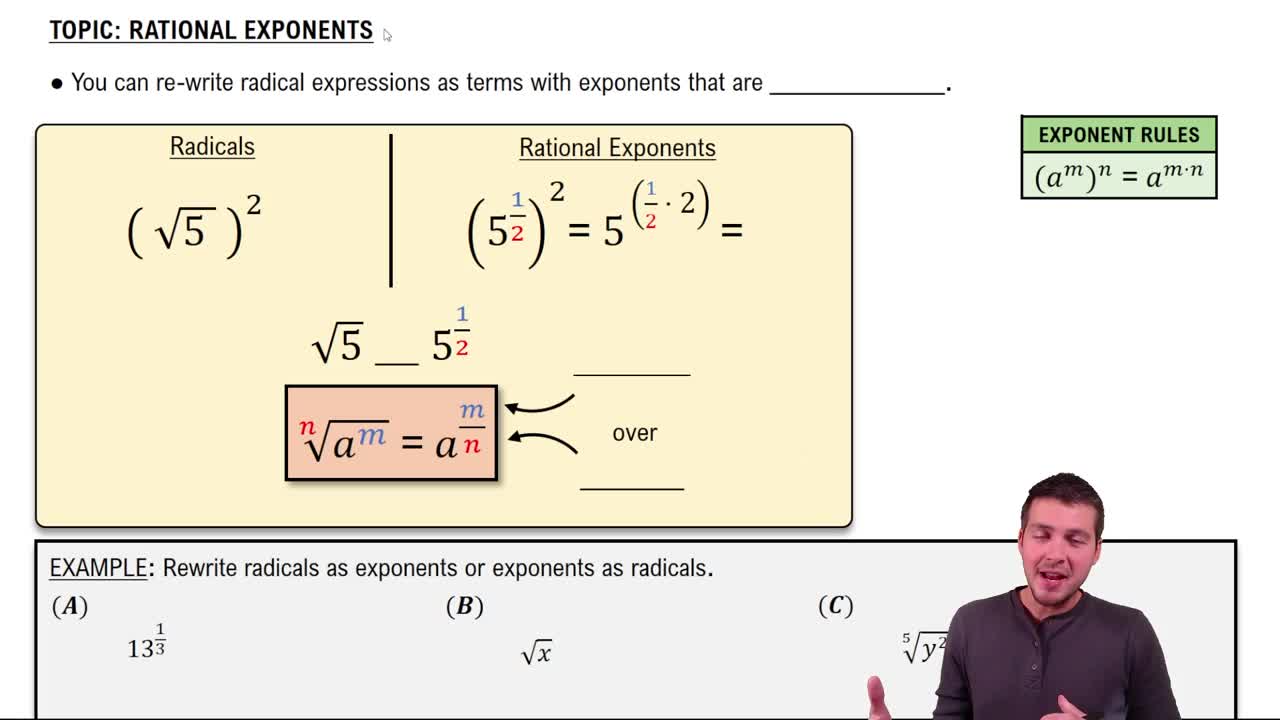Table of contents
- 0. Review of Algebra4h 16m
- 1. Equations & Inequalities3h 18m
- 2. Graphs of Equations43m
- 3. Functions2h 17m
- 4. Polynomial Functions1h 44m
- 5. Rational Functions1h 23m
- 6. Exponential & Logarithmic Functions2h 28m
- 7. Systems of Equations & Matrices4h 6m
- 8. Conic Sections2h 23m
- 9. Sequences, Series, & Induction1h 19m
- 10. Combinatorics & Probability1h 45m
0. Review of Algebra
Exponents
Problem 7a
Textbook Question
Evaluate each expression. 10^3
 Verified step by step guidance
Verified step by step guidance1
Identify the base and the exponent in the expression. Here, the base is 10 and the exponent is 3.
Understand that the exponent indicates how many times the base is multiplied by itself. In this case, 10 is multiplied by itself 3 times.
Write the expression as a multiplication of the base: 10 \times 10 \times 10.
Calculate the result of the multiplication step by step: first, multiply the first two 10s, then multiply the result by the third 10.
The final result is the value of 10 raised to the power of 3.
Recommended similar problem, with video answer:
 Verified Solution
Verified SolutionThis video solution was recommended by our tutors as helpful for the problem above
Video duration:
2mPlay a video:
Was this helpful?
Key Concepts
Here are the essential concepts you must grasp in order to answer the question correctly.
Exponents
Exponents represent the number of times a base is multiplied by itself. In the expression 10^3, the base is 10 and the exponent is 3, indicating that 10 is multiplied by itself three times: 10 × 10 × 10. Understanding exponents is crucial for simplifying expressions and performing calculations involving powers.
Recommended video:
Guided course

Rational Exponents
Base and Power
In exponential expressions, the base is the number being raised to a power, while the power (or exponent) indicates how many times to use the base in multiplication. For example, in 10^3, 10 is the base, and 3 is the power, which helps in determining the value of the expression through repeated multiplication.
Recommended video:

Powers of i
Order of Operations
The order of operations is a set of rules that dictates the sequence in which mathematical operations should be performed to ensure consistent results. When evaluating expressions like 10^3, it is important to follow these rules, which prioritize exponents before multiplication or addition, ensuring accurate calculations.
Recommended video:
Guided course

Performing Row Operations on Matrices

 7:39m
7:39mWatch next
Master Introduction to Exponent Rules with a bite sized video explanation from Patrick Ford
Start learningRelated Videos
Related Practice













